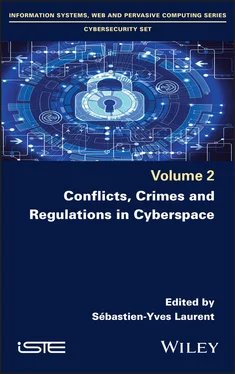Conflicts, Crimes and Regulations in Cyberspace focuses, on the one hand, on the actors of cyber states, also known as cyber bureaucracies, in Chapters 2, 8and 9, and, on the other hand, on the tools of cyber states, namely, norms (national and international law), in Chapters 4, 5and 7, as well as the strategic concepts used by the different actors (cybersecurity, cyberdefense and digital sovereignty 9 ). Our approach here is therefore that of the “meso-” level, which is rare, as international approaches to cyber in the academic literature of the Anglosphere rather tend to take into account “macro-” entities (states, international organizations, etc.). Thus, this book intends to contribute to the global academic debate on cyber issues.
Balzacq, T. and Cavelty, M.D. (2016). A theory of actor network for cyber-security. European Journal of International Security , 1–2, 176–198.
Bigelow, B. (2018). The topography of cyberspace and its consequences for operations. 10th International Conference on Cyber Conflict . NATO CCD COE Publications, Tallinn.
Calvo, A. (2014). Cyberwar is war: A critique of “hacking can reduce real-world violence”. Small Wars Journal , June [Online]. Available at: www.smallwarsjournal.com/jrnl/art/cyberwar-is-war[Accessed 18 June 2020].
Cavelty, M.D. (2018). Cybersecurity research meets science and technology studies. Politics and Governance , 6(2), 22–30.
Gartzke, E. (2013). The myth of cyberwar: Bringing war in cyberspace back down to earth. International Security , 38(2), 41–73.
Gorwa, R. and Smeets, M. (2019). Cyber Conflict in Political Science: A Review of Methods and Literature . ISA, Toronto.
Kuehl, D.T. (2009). From cyberspace to cyberpower: Defining the problem. In Cyberpower and National Security , Kramer, F.D., Starr, S.H., Wentz, L. (eds). National Defense University Press, Washington.
Laurent, S.-Y. (2021). Ce que le cyber (ne) fait (pas) aux relations internationales. Études Internationales .
Loiseau, H. and Waldispuehl, E. (2017). Cyberespace et science politique, de la méthode au terrain, du virtuel au réel . Presses de l’Université de Québec, Quebec City.
Loiseau, H., Ventre, D., Aden, H. (2021). Cybersecurity in Humanities and Social Sciences: A Research Methods Approach . ISTE Ltd, London, and Wiley, New York.
Musso, R.P. (2010). Le Web : nouveau territoire et vieux concepts. Annales des Mines. Réalités industrielles , 4, 75–83.
Reardon, R. and Choucri, N. (2012). The Role of Cyberspace in International Relations: A View of the Literature . ISA, San Diego.
Türk, P. and Vallar, C. (2017). La Souveraineté numérique. Le concept, les enjeux . Mare & Martin, Paris.
Valeriano, B. and Maness, R.C. (2018). How we stopped worrying about cyber doom and started collecting data. Politics and Governance , 6(5), 781–799.
1 Introduction written by Sébastien-Yves LAURENT.
2 1See Musso (2010).
3 2This makes it all the more important to highlight the role of pioneers Loiseau and Waldispuehl (2017) and Loiseau et al. (2021).
4 3For context in the literature, see Gorwa and Smeets (2019).
5 4The coordinator also wishes to thank Michel Courty for his work in structuring the manuscript.
6 5Quoted by Kuehl (2009).
7 6See two particularly successful examples, Balzacq and Cavelty (2016) and Cavelty (2018).
8 7See Reardon and Choucri (2012).
9 8See Laurent (2021).
10 9See Turk and Vallar (2017).
Конец ознакомительного фрагмента.
Текст предоставлен ООО «ЛитРес».
Прочитайте эту книгу целиком, купив полную легальную версию на ЛитРес.
Безопасно оплатить книгу можно банковской картой Visa, MasterCard, Maestro, со счета мобильного телефона, с платежного терминала, в салоне МТС или Связной, через PayPal, WebMoney, Яндекс.Деньги, QIWI Кошелек, бонусными картами или другим удобным Вам способом.











